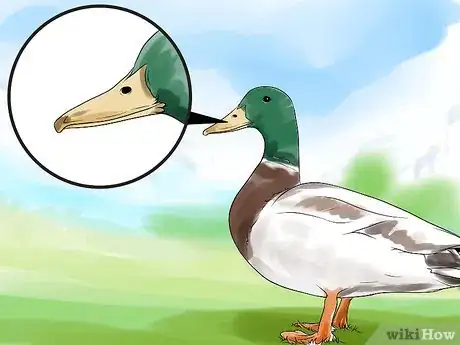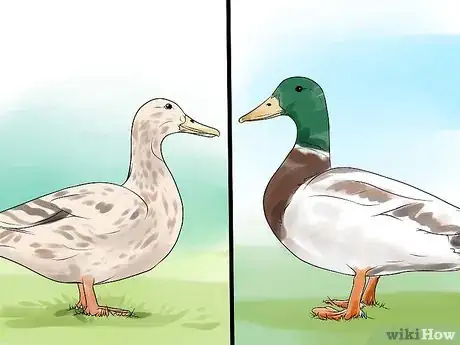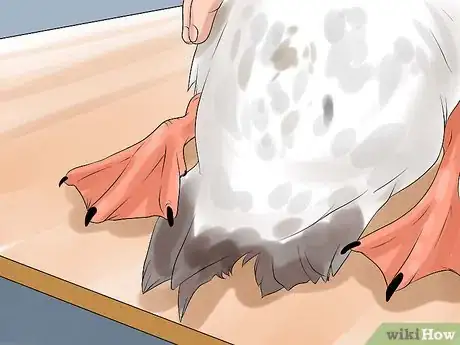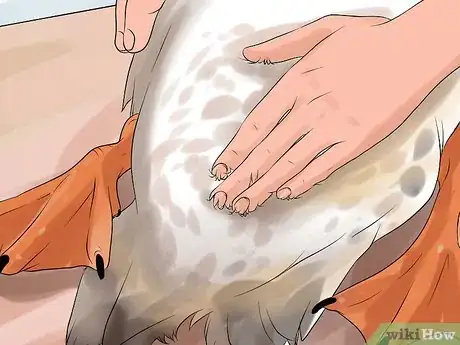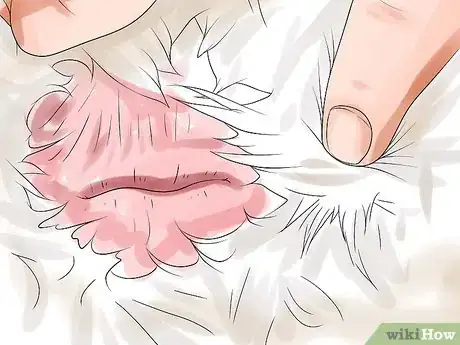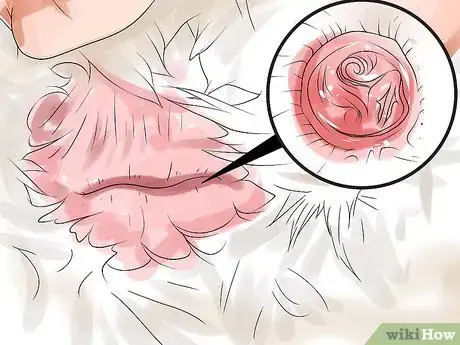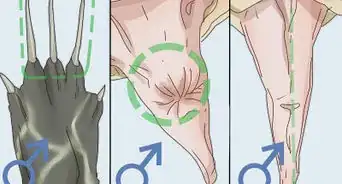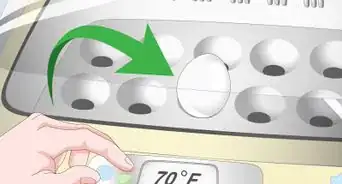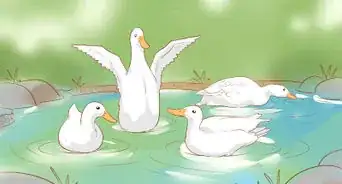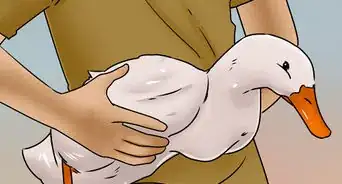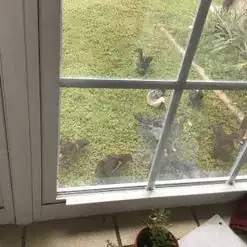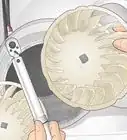This article was co-authored by Pippa Elliott, MRCVS. Dr. Elliott, BVMS, MRCVS is a veterinarian with over 30 years of experience in veterinary surgery and companion animal practice. She graduated from the University of Glasgow in 1987 with a degree in veterinary medicine and surgery. She has worked at the same animal clinic in her hometown for over 20 years.
There are 13 references cited in this article, which can be found at the bottom of the page.
wikiHow marks an article as reader-approved once it receives enough positive feedback. This article has 16 testimonials from our readers, earning it our reader-approved status.
This article has been viewed 835,808 times.
Ducks, which are also called waterfowl, are commonly found near lakes, rivers, and ponds.[1] Depending on the duck species, the differences between a male (‘drake') and female (‘hen') duck will not be readily obvious. However, once you know what to look and listen for, though, you will be better able to tell a male duck from a female duck.
Things You Should Know
- Distinguish between a male and female duck by checking the color of their feathers—male ducks are more colorful.
- Listen for a female duck's hard, loud quack and compare it to the male's softer quack if you can't see the bird.
- In a duck's cloaca, male ducks will have a penis protruding while female ducks will have an oviduct opening.
Steps
Identifying Coloration, Voice, and the Sex Feather
-
1Observe the duck's plumage (feathers). During the mating season, male ducks will have very bright coloration in their plumage to attract mates.[2] [3] After mating season, the male duck will molt and lose his bright coloration and resemble a female.[4]
- Mallard ducks are sexually dimorphic, which means the males and females look different from each other. The females are brown and relatively dowdy, whereas the males have a vivid purple sash on the wings and are iridescent colors.
- The male Canvasback has solid white to light gray plumage. His female counterpart has plumage that is grayish-brown.[5]
- The male Wood Duck has gray feathers with blue markings on the wings during mating season. The female's plumage is usually grayish-brown.[6]
- Male and female Mottled Ducks have similarly colored feathers, making it difficult to tell them apart by plumage alone.[7]
-
2Observe the bill color. Bill color is another way to tell the difference between a male and female duck. In many duck species, the bill color does not change during mating season, so this physical characteristic will stay the same throughout the year.
- In Mallards, the male duck has a bright yellow bill and the female has a brown and orange bill.[8] [9]
- In Mottled Ducks, the male duck has a bill that is a solid olive green to yellow color. The female's bill is brown to orange with dark splotches.[10]
- Male Wood Ducks have a red bill that has a patch of yellow at the bottom.[11]
- During mating season, the bill of the Ruddy Duck changes to a bright baby blue.
Advertisement -
3Look at the duck's size. Across species, male ducks tend to be larger than female ducks. In addition to having a larger body size in general, male Mallards, Rouens, and Welsh Harlequins have larger heads and thicker necks than the females.[12]
-
4Look for a curled feather near the tail. Male ducks will have an upwardly curled feather near the tail; this is known as the ‘sex feather.' This feather, which will become noticeable in male ducks when they are between two and four months old, remains after molting.[13] [14]
- Females do not have a sex feather.[15]
-
5Listen to a duck's quack. Female ducks tend to have a loud and hard quack. The quack of male ducks is usually soft and rough. If you have ducks as pets and you are comfortable handling them, you can gently hold the duck by its tail until it quacks.[16]
- The sound of a quack can be used to differentiate between male and female ducks from the time that ducks are about one month old.[17]
- In Muscovy ducks, the female's quack sounds like a trill or a coo. A male Muscovy will make a quack that's very deep and breathy (sounds like 'huch-uch-uch').[18]
- The female Grey Teal makes a quack that sounds like a cackling noise, which differentiates it from the male Grey Teal.[19]
Examining a Duck's Cloaca
-
1Place the duck on his back on a table. Cloacal examination, also known as venting, is another method of determining the sex of a duck. It is used in ducks that are sexually monomorphic (same external features between males and females), but is also used in ducklings as young as 12 days old. Venting is a difficult procedure to perform; if you are not comfortable with doing it yourself, ask someone who is more experienced to do it for you.[20]
- When you place the duck on the table, position it so that its breast is facing up and its legs are facing away from you. The tail should drape over the edge of the table so that it can be bent down to examine the cloaca.[21] [22]
- If you do not have a solid surface on which you can lay the duck, you can also kneel down and lay the duck on your leg so that its tail can be bent over your knee.[23]
- Venting is even more difficult in ducklings than adult ducks, so ask a professional to do this.
-
2Identify the cloaca. The cloaca is a small external opening near the duck's rear. A duck's genital and reproductive tracts end at the cloaca. Use your fingers to search amongst the feathers to locate this external opening.[24]
-
3Expose the cloacal walls and genitals. To do this, use your index fingers to fold down the tail and apply opposite, upward pressure on the other side of the tail with your middle and ring fingers. Next, place your thumbs on both sides of the cloaca and slowly move your thumbs away from each other.[25]
- Use gentle pressure while attempting to expose the cloacal walls and genitals. Too much pressure can cause serious injury to the duck.
- An alternative approach to exposing the cloacal walls and genitals is to insert your finger about one centimeter into the cloaca and move your finger in a circular motion to relax the sphincter that keeps the cloaca closed.[26] Once the sphincter is relaxed, you can use your thumbs to ease the cloacal walls apart.
-
4Identify the reproductive organs within the cloaca. By exposing the cloacal walls and genitals, you should be able to determine whether the duck is male or female. The duck is a male if a penis protrudes from the cloaca.[27] A female duck will have an oviduct opening in the cloaca.[28]
- In male ducks, the penis will be small and unsheathed (uncovered) in immature ducks and large and sheathed in adults.[29]
Warning
- Venting should not be done in ducks who are only a day-old or are newly hatched. If done incorrectly, venting can cause serious injury or death in ducks that are this young.[33]
References
- ↑ https://animalcorner.co.uk/animals/ducks/
- ↑ https://animalcorner.co.uk/animals/ducks/
- ↑ http://www.wildfowl-photography.co.uk/identification/female-ducks.htm
- ↑ https://animalcorner.co.uk/animals/ducks/
- ↑ http://birdweb.org/birdweb/bird/canvasback
- ↑ https://www.nwf.org/Wildlife/Wildlife-Library/Birds/Wood-Duck.aspx
- ↑ http://myfwc.com/wildlifehabitats/profiles/birds/waterfowl/mottled-ducks/
- ↑ http://www.allaboutbirds.org/guide/Mallard/id
- ↑ http://keeping-ducks.bafree.net/how-to-tell-the-difference-between-male-and-female-ducks.php
- ↑ http://myfwc.com/wildlifehabitats/profiles/birds/waterfowl/mottled-ducks/
- ↑ https://www.nwf.org/Wildlife/Wildlife-Library/Birds/Wood-Duck.aspx
- ↑ http://www.metzerfarms.com/SexingBirds.cfm
- ↑ http://keeping-ducks.bafree.net/how-to-tell-the-difference-between-male-and-female-ducks.php
- ↑ http://www.nzdl.org/gsdlmod?e=d-00000-00---off-0fnl2.2--00-0----0-10-0---0---0direct-10---4-------0-1l--11-en-50---20-about---00-0-1-00-0--4----0-0-11-10-0utfZz-8-00&a=d&c=fnl2.2&cl=CL1.1&d=HASH01f4d3b2be7f17d0abb3d580.6.4#HASH01f4d3b2be7f17d0abb3d580.6.4
- ↑ http://www.nzdl.org/gsdlmod?e=d-00000-00---off-0fnl2.2--00-0----0-10-0---0---0direct-10---4-------0-1l--11-en-50---20-about---00-0-1-00-0--4----0-0-11-10-0utfZz-8-00&a=d&c=fnl2.2&cl=CL1.1&d=HASH01f4d3b2be7f17d0abb3d580.6.4#HASH01f4d3b2be7f17d0abb3d580.6.4
- ↑ http://www.nzdl.org/gsdlmod?e=d-00000-00---off-0fnl2.2--00-0----0-10-0---0---0direct-10---4-------0-1l--11-en-50---20-about---00-0-1-00-0--4----0-0-11-10-0utfZz-8-00&a=d&c=fnl2.2&cl=CL1.1&d=HASH01f4d3b2be7f17d0abb3d580.6.4#HASH01f4d3b2be7f17d0abb3d580.6.4
- ↑ http://keeping-ducks.bafree.net/how-to-tell-the-difference-between-male-and-female-ducks.php
- ↑ http://www.majesticwaterfowl.org/artquacks.htm
- ↑ http://www.gma.vic.gov.au/education/better-hunting/know-your-waterfowl/game-waterfowl-guide
- ↑ http://keeping-ducks.bafree.net/how-to-tell-the-difference-between-male-and-female-ducks.php
- ↑ http://www.fao.org/docrep/005/y4359e/y4359e07.htm
- ↑ http://www.gma.vic.gov.au/education/better-hunting/know-your-waterfowl/game-waterfowl-guide
- ↑ http://www.fao.org/docrep/005/y4359e/y4359e07.htm
- ↑ http://www.gma.vic.gov.au/education/better-hunting/know-your-waterfowl/game-waterfowl-guide
- ↑ http://www.gma.vic.gov.au/education/better-hunting/know-your-waterfowl/game-waterfowl-guide
- ↑ http://www.fao.org/docrep/005/y4359e/y4359e07.htm
- ↑ http://www.gma.vic.gov.au/education/better-hunting/know-your-waterfowl/game-waterfowl-guide
- ↑ http://www.gma.vic.gov.au/education/better-hunting/know-your-waterfowl/game-waterfowl-guide
- ↑ http://www.gma.vic.gov.au/education/better-hunting/know-your-waterfowl/game-waterfowl-guide
- ↑ http://keeping-ducks.bafree.net/how-to-tell-the-difference-between-male-and-female-ducks.php
- ↑ http://www.allaboutbirds.org/guide/Mallard/id
- ↑ http://www.wildfowl-photography.co.uk/identification/female-ducks.htm
- ↑ http://www.pet-informed-veterinary-advice-online.com/bird-sexing.html#bird-vent
About This Article
To tell the difference between male and female ducks, look at the duck’s feathers during mating season since male ducks will have very bright coloration to attract mates. Another way to tell the difference between male and female ducks is bill color. For example, in Mallards the male has a bright yellow bill and the female has a brown and orange bill. Male ducks also tend to be larger than females and typically have a curled feather near the tail. To tell a male from a female duckling, look to see if an oviduct opening or a penis is visible from the cloaca. To learn more from our Veterinarian co-author, like how to tell a duck's sex by the noise it makes, keep reading!

